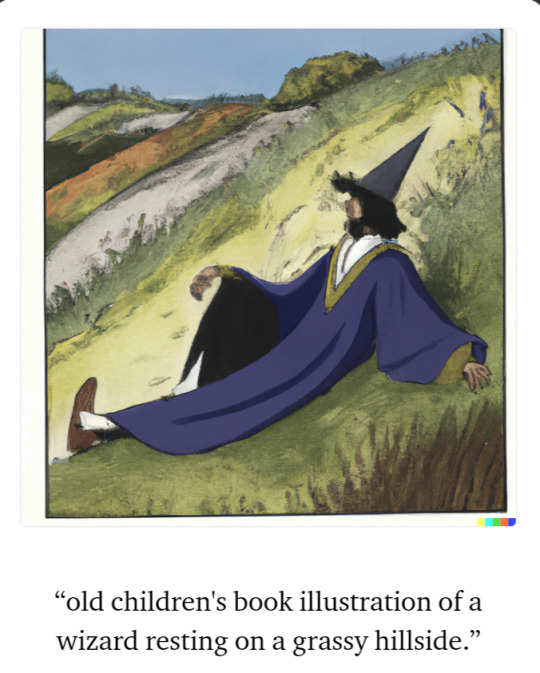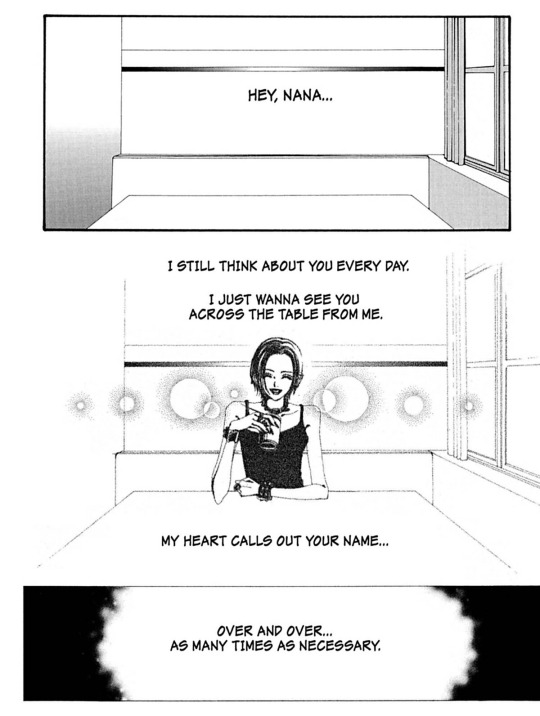#love using the ''children's book illustration'' style on ai. its always good
Text
sorry to all my neuralblender wizards but this is my new favorite wizard i've made

#unreality#dall e#dall e 2#dalle2#seven's ai adventure#love using the ''children's book illustration'' style on ai. its always good#wizardcore
5K notes
·
View notes
Note
I'm going to use this part of what you said in a previous answer that made me really curious "the way of the authors to tell the story is another matter" to know your top 5 (or ~10) of that :)
Ah :D I guess the easier way to put it would be “This time I chose my favourite styles basing on art style mostly, but if I were to choose my fav storytelling/mix of art and how authors tells it/what they want to transmit, the odrer/the list would be different” :”) So some authors/stories on the list of my fav storytelling (not sure if it's the right term for what i mean but let's use this) are the same I put in the previous list. The titles and authors won’t be surprise for you, but I’ll list them anyway. Warning: I love talking about such things a lot, so I suddenly wrote a lot.
(Ask me my top 5-10 anything)
1. Literally anything by Takaya Natsuki. You have no idea how #tired I am of all the discussions about both adaptations of her Furuba (which is better which is worse no listen to me bc I Have an Opinion of High Authority) when not a single adaptation quite got her style in storytelling, foreshadowing and especially presenting her characters’ personal drama. I think I espcially love her for not throwing it all in your face right away, being careful at hinting at things (so that you don’t quite get some parts of the characters’ thoughts and inner struggles until you learn the facts and it hits you) and for leaving you some space to use your own brain what you think about this or that storyline. (Tamura Yumi does it too which makes her my second fave author). Also, years after reading and rereading her works I see better how storylines are entwinted and unfolding, and it still makes me yell “HOW does she do it” every time I go back to Furuba and her other works and see something new. I love her Hoshi wa Utau (which hits hard and is painfully real in the matter of parents/children’s conflicts), and Liselotte to majo no mori (darkish fairytale with hopeful messages) and wish more people knew about them too, not only Furuba.

2. Kouno Fumiyo’s Yunagi no Machi Sakura no Kuni. I first read this manga a long time ago and was dying of happiness when it got published in my country bc oh my gosh. It’s a historical thing, it’s a heavy thing, she does have such unique style (my first thought was ”ah looks cute, like children books illustrations” and then it killed me) and approach to place panels on pages or transitions between scenes or past and present (I think some comic researcher or smth even called it innovative). The page that struck me the most was a spread near the end of this story, presenting a character in his older years sitting on the beach of a river in Hiroshima and him in the same place right after the war. Perhaps it doesn’t sound so original but this work and these two pages live rent free in my soul to this day.

3. Ando Yuki’s oneshots (and Machida-kun). She is my favourite short stories author, she just knows how to tell it so that I got tuned in from the start. Be it a school slice of life or basically Edith Piaf’s song Hymne à l'amour presented in the form of manga oneshot, they give me immense joy. And oh, there’s almost always a twist near the ending I can’t predict. Her characters act a bit weird and take weird decisions sometimes but I think it’s what makes them feel so real to me.

And it’s cheating, but while I’m talking about oneshots, I want to mention Midorikawa Yuki and her shorter-than-Natsume stories. Because they give me a similar feeling to Ando’s oneshots - the atmosphere is different, but the way they touch my heart is the same. Don’t get me wrong, I love Natsume and its structure (main characters and their personal jouney through unrelated stories of other people/not humans), but I love Midorikawa’s shorter stories much more.
4. Takamatsu Misaki’s Skip to Loafer. One of the best slice stories I’ve ever read. Right amount of drama and comedy, a cast of characters with different problems and motivations. I can’t help but think “Oh I wish I were able to create a story like this one day”. Also, someone wrote about it: “let me live the wholesome high school life i didnt have” and ugh I felt it :”))

5. Yazawa Ai’s stories: Nana and Gokinjo Monogatari. Did “Nee, Nana” moments kill my soul every time it was used in the story? Yes, absolutely. Did it make me cry? Don’t even ask.

6. Nishi Keiko’s stories: Otoko no Isshou, Koi to Gunkan. A person I know described her stories like this: “If life goes the wrong way, it’s better to go home”, and I think it sums it up. Both of the stories I listed are about ordinary life in small towns, they both me melancholic and somehow cozy feeling. Both stories have themes and characters that don’t really interest me much, but when I read them, I usually cry. It’s another A+ slice of life author imo.

7. Tsukuba Sakura’s Mekakushi no Kuni. It’s dear to me for special reasons. There a girl who sometimes sees future when touches other people, there is a boy who sees the past all the time he does the same, there’s another boy... And NO evil organizations chasing them for their superpowers, NO global plots or problems or author’s will to condemn society, no deep philosophy questions about time and so on. Just normal slice of life of not so normal peoplewho try to cope with this particularity they have and fit the world they live in. (I wish authors realized the potential of such slice of life centered urban fantasy but they keep failing me aiming at the Global, sigh)

8. Torino Nanko’s Toripan. It’s basically authors essays on her daily life and mostly birdwatching, but ugh it’s so good. Peak comedy about birds and heartfelt pages for when she speaks about her memories or remarks on nature, it’s so full of love towards this world and life. After I read Toripan I feel like I become kinder and better :DD

(author’s A+ faces and haiku about sparrows in the winter)
9. Watanuki Yoshiko’s Manatsu no Delta. I read it some time ago and my first thought was “Wow, this IS how you touch an unpleasant yet existing problem”. I’ll certainly be waiting for this author’s other works.

10. Ikuemi Ryo’s stories, especially the ones featuring metaphorical ghosts (Kiyoku Yawaku, Torch Song Ecology) and Taiyou ga Mite Iru. Joseis with ghosts are my fave thing on earth, and Ikuemi’s great at it. But she can make any theme totally worth digging into, be it school life or cheating and complicated family relationships. I think TGM is her work that left the deepest trace in my soul because I was reading it when it was ongoing, for three years, and it’s basically just something that makes you die slowly looking at how not so bad people fk up their life decisions bc of their unresolved traumas and issues but you can’t take your eyes of it and then need several years of therapy after reading such manga. And she doesn’t even preech or say you should not live like this. She’s like “this is a life story I want to tell, take whatever you want from it” and I’m like “gooosh this is so painful and looks so real and makes me feel things, I love it”. Ikuemi Power as it is. (Life teaches me nothing, I lowkey want to read something like TGM again and Akaneda Yuki’s Saraba Yoki Hi fulfills this wish of mine, but uh I’m so glad it’s rarely updated)

(text: Nire is here to kill me)
Thanks for such ask, it was fun :D
23 notes
·
View notes
Text
Nico Acosta of Twilio: Channels Are Converging to Improve Experiences Throughout the Customer Journey
Last month I had the opportunity to check out Twilio’s annual user conference, Signal. Twilio, a platform that allows developers to build communications-enabled (voice, text, chat, email), shared a few stats that really caught my attention:
Twilio sends 50 billion emails a month on behalf of their customers
They send 200 million SMS messages a day
53% of WhatsApp messages Twilio customers sent got a reply
With numbers like these it’s safe to say that Twilio has a pretty good pulse on how current and emerging communication channels are shaping customer engagement, experiences and journeys. And I had a chance to speak with Nico Acosta, Twilio’s Director of Product for AI/ML, to dig in a bit on what they’re seeing in terms of how voice, chat and other new channels are impacting the customer journey.
Below is an edited transcript of our conversation. To see the whole interview watch the video or click on the embedded SoundCloud below.
Looking at Customer Journey Channels
Brent Leary: I love this phrase that Jeff Lawson said around the customer journey is becoming the company’s brand. And what role does voice and AI play in that journey?
Nico Acosta: What we’re seeing a lot is all the channels are coming together. They’re converging in the same journey, not necessarily together in the same experience, but in the same journey and customers are interacting with businesses for different use cases through different channels.
One of the parts that we’re most excited about in voice is all the conversation of AI; where this goes hand in hand with what we do in the contact center. We believe that when you think about voice, and especially in the context of a contact center, there’s been this very deeply rooted tradeoff between customer experience and operational efficiency. And there’s always somebody inside of companies that has that knob for how many agents should I staff versus how tolerant am I or how long do I want our customers to wait on hold? And there’s always a decision to be made.
Twilio and AI Research
Brent Leary: There’s one.
Nico Acosta: And when we started looking at this at Twilio and doing all the AI research, we started questioning that. It’s like is that a tradeoff that we are going to have to live with forever or can we build a platform that enables a better customer experience with greater operational efficiency? This is a long journey, but we believe we are on that track where we can automate certain experiences that are well-defined, that are repeatable where customers actually prefer self-service and leverage the power of agents in the contact center when you need to.
Brent Leary: When they need it, yeah.
Nico Acosta: And I’ll give you a couple of examples. You think about three types of customer journeys. Booking an appointment. It’s a well-defined task. You can automate it. If you can, customers will prefer self-service.
Part Virtual Assistant, Part Human
Brent Leary: Right.
Nico Acosta: But then, you might have experiences that are hybrid, that are part virtual assistant, part human. For example, buying life insurance. You might want to ask a series of qualification questions up front, use that intelligence to route intelligently, prioritize and cue to the right agent that has the right specialty and then continue the conversation with a human in a much more consultative way. So while you might have automated the questions of what state do you live, what’s your yearly income, do you smoke, how many children do you have?
Then, when you hand off to an agent and that is a prioritize, you can talk about much broader things of what are your life goals and where are you in your financial planning and all these things that are much more suitable for human conversation. So at Twilio, we believe that it’s really the combination of these two that are going to transform voice and that’s what we’re building with Auto Pilot and that’s what we’re building with Flex, really the conversational AI that works in consonance with the contact center.
Engaging Within Customer Journey Channels
Brent Leary: I think there was also a statement that conversations are eating app’s lunch. Is that part of what you just illustrated? Are these conversations, whether it’s voice or via text, they’re coming together over whatever channel it is, but it’s that opportunity to interact in real time, it’s changing the way customer engagement is done and changing the relationship that customers have in general with the vendors they’re talking to?
Nico Acosta: Yeah, when you look at the history of computing, we started with the command-line interface, which we actually shifted to the command-line interface (CLI) is kind of coming back full circle, which is awesome. We started with the CLI’s right, then the Gooey right, then probably could argue the next big user interface evolution was the Touch. But then it kind of hasn’t evolved much since then. The Gooey was invented …
The Power of Conversations
Brent Leary: Like 35-40 years ago.
Nico Acosta: Yeah, so like early 80s, we’re already seeing products with graphical user interfaces. What is powerful about conversations is that it’s a different paradigm to interact with systems. You’re talking to systems in natural language where that’s a virtual assistant or a bot or you’re just interacting with a routing layer that gets you to a right person inside a company. But just the idea of why don’t companies and systems and computers adapt to how we communicate? Not the opposite.
And conversational interfaces, again, whether it’s a bot or a human, they have this unique property that you don’t need to learn how you use them. You just talk, you just say, you just text. And it depends on the customer journey that you want to build. There might be some parts of that journey that are automated, there might be some parts that are handled by contacts and maybe some parts that are handled by a field worker who’s like the person actually delivering or … and that’s the beauty of the software, the intelligence, the channels and the software orchestration that we provide.
How Has Voice Changed Customer Engagement?
Brent Leary: So, what does voice in particular, what does that add or change aside from the other channels that we talked about that are more text based; where do you see voice changing customer engagement or adding something that’s not there in these other channels we’ve talked about?
Nico Acosta: Yeah, so it’s an interesting question. When I talk to a lot of developers all around the world and a lot of companies building all sorts of customer journeys. When I talk to the IVR developers, they’re excited about chat.
Brent Leary: Really?
Nico Acosta: And when I talk to chat bot developers, they’re excited about voice.
Your Channel’s Role in the Customer Journey
Brent Leary: Interesting.
Nico Acosta: It goes to the point of convergence and I think each of these channels will have a role in the customer journey. We truly believe that real-time channels whether it’s voice, whether it’s video, and then you can split voice into yet two other subcategories where it’s like real-time voice where you’re talking to somebody and a home assistant style voice, the Alexa system where in a sync or turn by turn voice.
Brent Leary: Oh, right.
Nico Acosta: And I think it has, if you take a customer journey, each channel has its spot. You might get car insurance via a text chat. And then you type all the information that is needed and it goes back and forth, back and forth. If you get into a car accident, you need help, you call and you do not want to talk to bot. You want to be connected to the emergency response team, you want somebody on the phone immediately and you want that customer empathy.
When you file the claim and then you’re like when am I going to get paid? That’s something pretty top of mind, right? You might use Alexa, say hey Alexa, what’s the status of my claim? It’s probably easier than doing anything.
Looking for the App
Brent Leary: Calling and yeah.
Nico Acosta: Easier than pulling your phone, looking for the app, right, it’s easier than anything. So, all these channels where it’s voice, where it’s messaging, will all have a spot in the customer journey.
Brent Leary: The last part of the keynote where the use case … it was a pretty funny use case, but where the guy is at the airport and he left something, he left a piece of his luggage and he’s trying to make his connecting flight and so he reaches out in one channel and the person on the other side needs to bring in somebody else [on a different channel], then they start bringing in the pilot [on another channel], they start bringing all … but it was a really fascinating use case of how you don’t need to know what channel somebody is on. You can reach them and you reach the right person at the right time to bring in the right information. How far away are we from that?
Nico Acosta: We’re doing that every day.
Comparing Customer Experience
Brent Leary: Really?
Nico Acosta: So take … compare the Uber experience that we power versus the taxi dispatcher. You want to talk to the Uber driver, you click a button, you talk … you want to know where your Uber is, click a button, you talk to the Uber driver. The Uber driver is the best person in the world to talk to at that point in time. They know where they are. They know if they’re hitting traffic, they know. And if you want to say hey no, on this corner versus on that corner, they’re the right person to talk to. You’re talking to the right person inside the organization.
Take the experience with before with taxi dispatchers. Like oh no, I’m going to call the taxi dispatcher to let them know that I’ll be on this side of the conference hall, not on that side and then they take the message, they try to radio down. So and we’re seeing the same use cases with multi-party where it’s a three-party transaction for example where there’s the food, the customer, the deliverer and it’s a reality today.
Brent Leary: I’m definitely looking forward to getting more of those experiences, having companies create more of those kinds of experiences.
This article, “Nico Acosta of Twilio: Channels Are Converging to Improve Experiences Throughout the Customer Journey” was first published on Small Business Trends
https://smallbiztrends.com/
The post Nico Acosta of Twilio: Channels Are Converging to Improve Experiences Throughout the Customer Journey appeared first on Unix Commerce.
from WordPress https://ift.tt/2QantC8
via IFTTT
0 notes
Text
Nico Acosta of Twilio: Channels Are Converging to Improve Experiences Throughout the Customer Journey
Last month I had the opportunity to check out Twilio’s annual user conference, Signal. Twilio, a platform that allows developers to build communications-enabled (voice, text, chat, email), shared a few stats that really caught my attention:
Twilio sends 50 billion emails a month on behalf of their customers
They send 200 million SMS messages a day
53% of WhatsApp messages Twilio customers sent got a reply
With numbers like these it’s safe to say that Twilio has a pretty good pulse on how current and emerging communication channels are shaping customer engagement, experiences and journeys. And I had a chance to speak with Nico Acosta, Twilio’s Director of Product for AI/ML, to dig in a bit on what they’re seeing in terms of how voice, chat and other new channels are impacting the customer journey.
Below is an edited transcript of our conversation. To see the whole interview watch the video or click on the embedded SoundCloud below.
Looking at Customer Journey Channels
Brent Leary: I love this phrase that Jeff Lawson said around the customer journey is becoming the company’s brand. And what role does voice and AI play in that journey?
Nico Acosta: What we’re seeing a lot is all the channels are coming together. They’re converging in the same journey, not necessarily together in the same experience, but in the same journey and customers are interacting with businesses for different use cases through different channels.
One of the parts that we’re most excited about in voice is all the conversation of AI; where this goes hand in hand with what we do in the contact center. We believe that when you think about voice, and especially in the context of a contact center, there’s been this very deeply rooted tradeoff between customer experience and operational efficiency. And there’s always somebody inside of companies that has that knob for how many agents should I staff versus how tolerant am I or how long do I want our customers to wait on hold? And there’s always a decision to be made.
Twilio and AI Research
Brent Leary: There’s one.
Nico Acosta: And when we started looking at this at Twilio and doing all the AI research, we started questioning that. It’s like is that a tradeoff that we are going to have to live with forever or can we build a platform that enables a better customer experience with greater operational efficiency? This is a long journey, but we believe we are on that track where we can automate certain experiences that are well-defined, that are repeatable where customers actually prefer self-service and leverage the power of agents in the contact center when you need to.
Brent Leary: When they need it, yeah.
Nico Acosta: And I’ll give you a couple of examples. You think about three types of customer journeys. Booking an appointment. It’s a well-defined task. You can automate it. If you can, customers will prefer self-service.
Part Virtual Assistant, Part Human
Brent Leary: Right.
Nico Acosta: But then, you might have experiences that are hybrid, that are part virtual assistant, part human. For example, buying life insurance. You might want to ask a series of qualification questions up front, use that intelligence to route intelligently, prioritize and cue to the right agent that has the right specialty and then continue the conversation with a human in a much more consultative way. So while you might have automated the questions of what state do you live, what’s your yearly income, do you smoke, how many children do you have?
Then, when you hand off to an agent and that is a prioritize, you can talk about much broader things of what are your life goals and where are you in your financial planning and all these things that are much more suitable for human conversation. So at Twilio, we believe that it’s really the combination of these two that are going to transform voice and that’s what we’re building with Auto Pilot and that’s what we’re building with Flex, really the conversational AI that works in consonance with the contact center.
Engaging Within Customer Journey Channels
Brent Leary: I think there was also a statement that conversations are eating app’s lunch. Is that part of what you just illustrated? Are these conversations, whether it’s voice or via text, they’re coming together over whatever channel it is, but it’s that opportunity to interact in real time, it’s changing the way customer engagement is done and changing the relationship that customers have in general with the vendors they’re talking to?
Nico Acosta: Yeah, when you look at the history of computing, we started with the command-line interface, which we actually shifted to the command-line interface (CLI) is kind of coming back full circle, which is awesome. We started with the CLI’s right, then the Gooey right, then probably could argue the next big user interface evolution was the Touch. But then it kind of hasn’t evolved much since then. The Gooey was invented …
The Power of Conversations
Brent Leary: Like 35-40 years ago.
Nico Acosta: Yeah, so like early 80s, we’re already seeing products with graphical user interfaces. What is powerful about conversations is that it’s a different paradigm to interact with systems. You’re talking to systems in natural language where that’s a virtual assistant or a bot or you’re just interacting with a routing layer that gets you to a right person inside a company. But just the idea of why don’t companies and systems and computers adapt to how we communicate? Not the opposite.
And conversational interfaces, again, whether it’s a bot or a human, they have this unique property that you don’t need to learn how you use them. You just talk, you just say, you just text. And it depends on the customer journey that you want to build. There might be some parts of that journey that are automated, there might be some parts that are handled by contacts and maybe some parts that are handled by a field worker who’s like the person actually delivering or … and that’s the beauty of the software, the intelligence, the channels and the software orchestration that we provide.
How Has Voice Changed Customer Engagement?
Brent Leary: So, what does voice in particular, what does that add or change aside from the other channels that we talked about that are more text based; where do you see voice changing customer engagement or adding something that’s not there in these other channels we’ve talked about?
Nico Acosta: Yeah, so it’s an interesting question. When I talk to a lot of developers all around the world and a lot of companies building all sorts of customer journeys. When I talk to the IVR developers, they’re excited about chat.
Brent Leary: Really?
Nico Acosta: And when I talk to chat bot developers, they’re excited about voice.
Your Channel’s Role in the Customer Journey
Brent Leary: Interesting.
Nico Acosta: It goes to the point of convergence and I think each of these channels will have a role in the customer journey. We truly believe that real-time channels whether it’s voice, whether it’s video, and then you can split voice into yet two other subcategories where it’s like real-time voice where you’re talking to somebody and a home assistant style voice, the Alexa system where in a sync or turn by turn voice.
Brent Leary: Oh, right.
Nico Acosta: And I think it has, if you take a customer journey, each channel has its spot. You might get car insurance via a text chat. And then you type all the information that is needed and it goes back and forth, back and forth. If you get into a car accident, you need help, you call and you do not want to talk to bot. You want to be connected to the emergency response team, you want somebody on the phone immediately and you want that customer empathy.
When you file the claim and then you’re like when am I going to get paid? That’s something pretty top of mind, right? You might use Alexa, say hey Alexa, what’s the status of my claim? It’s probably easier than doing anything.
Looking for the App
Brent Leary: Calling and yeah.
Nico Acosta: Easier than pulling your phone, looking for the app, right, it’s easier than anything. So, all these channels where it’s voice, where it’s messaging, will all have a spot in the customer journey.
Brent Leary: The last part of the keynote where the use case … it was a pretty funny use case, but where the guy is at the airport and he left something, he left a piece of his luggage and he’s trying to make his connecting flight and so he reaches out in one channel and the person on the other side needs to bring in somebody else [on a different channel], then they start bringing in the pilot [on another channel], they start bringing all … but it was a really fascinating use case of how you don’t need to know what channel somebody is on. You can reach them and you reach the right person at the right time to bring in the right information. How far away are we from that?
Nico Acosta: We’re doing that every day.
Comparing Customer Experience
Brent Leary: Really?
Nico Acosta: So take … compare the Uber experience that we power versus the taxi dispatcher. You want to talk to the Uber driver, you click a button, you talk … you want to know where your Uber is, click a button, you talk to the Uber driver. The Uber driver is the best person in the world to talk to at that point in time. They know where they are. They know if they’re hitting traffic, they know. And if you want to say hey no, on this corner versus on that corner, they’re the right person to talk to. You’re talking to the right person inside the organization.
Take the experience with before with taxi dispatchers. Like oh no, I’m going to call the taxi dispatcher to let them know that I’ll be on this side of the conference hall, not on that side and then they take the message, they try to radio down. So and we’re seeing the same use cases with multi-party where it’s a three-party transaction for example where there’s the food, the customer, the deliverer and it’s a reality today.
Brent Leary: I’m definitely looking forward to getting more of those experiences, having companies create more of those kinds of experiences.
This article, “Nico Acosta of Twilio: Channels Are Converging to Improve Experiences Throughout the Customer Journey” was first published on Small Business Trends
https://smallbiztrends.com/
The post Nico Acosta of Twilio: Channels Are Converging to Improve Experiences Throughout the Customer Journey appeared first on Unix Commerce.
from WordPress https://ift.tt/2QantC8
via IFTTT
0 notes